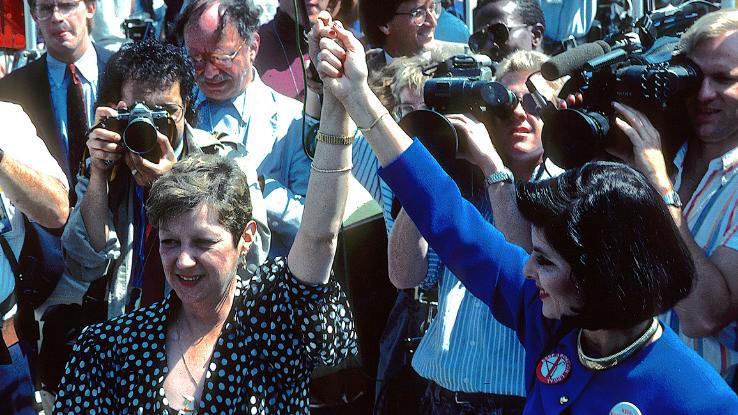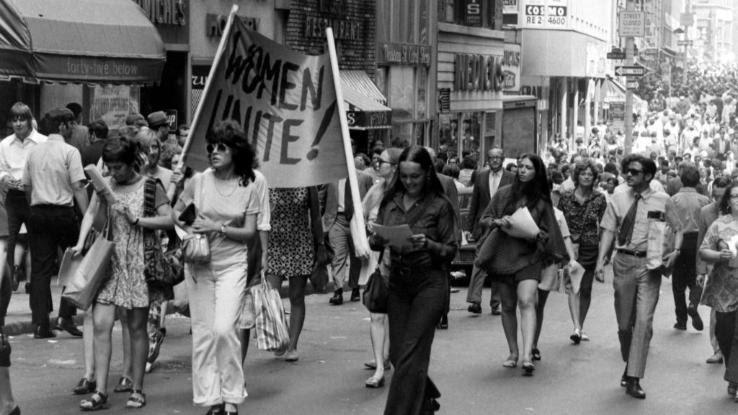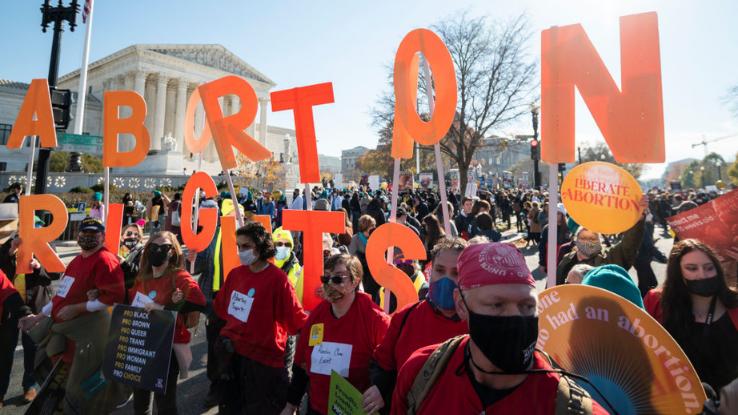Number of Babies Killed in Abortions Since Roe V. Wade

Roe v. Wade remains one of the well-nigh controversial court cases in American history. In 1973, the Supreme Court prohibited states from banning ballgame and barred the government from interfering with a adult female's right to terminate a pregnancy. Americans remain largely divided on Roe v. Wade'due south outcome, particularly when similar cases surface, such as the Dobbs v. Jackson Supreme Courtroom hearing on December 1, 2021.
The Gestational Age Act lies at the center of Dobbs v. Jackson, which bans all abortions after the 15th calendar week of pregnancy – save for life-threatening emergencies and abnormalities. The Jackson Women's Health Organization argued that this act was unconstitutional, prompting Mississippi Land Health Officeholder Thomas Dobbs to refute Jackson's claim. The Supreme Courtroom presided over their statement on Dec ane, but they are unlikely to denote their decision before the summer of 2022.
In the meantime, Americans volition have aplenty opportunity to contemplate whetherDobbs five. Jackson threatens the legacy of Roe v. Wade. Knowing the history behind these courtroom cases is essential to understanding how they impact pregnant individuals across the unabridged Us.
The Early History of Reproductive Rights
When Roe v. Wade made its way to the Supreme Court (SCOTUS), the battle for reproductive rights, which was centered on cisgender women at the time, was not new. Some of the earliest American abortion regulations formed in the 1820s and '30s, mainly stemming from the fact that abortion methods at the time were deemed dangerous.

By the 1850s, the American Medical Association began to phone call for the de-legalization of all abortions — except for cases in which a meaning person's life was at risk. The alleged motive behind this determination was to ensure that the offspring of immigrants or lower-form folks didn't outnumber the offspring of upper-class folks. That controversial discourse was oft accompanied by appeals to religious morality.
Within just a few decades, abortion was illegal in much of the United States. That didn't stop doctors in the 1880s from performing these procedures, nor did it stop certain citizens from needing them. However, safe abortions were largely sectional to upper-class, white cisgender women; other people seeking reproductive aid were forced to resort to dangerous, "back-aisle" methods, which were plagued by tremendous wellness risks and legal complications.
During the tardily 1950s and early '60s, women'south rights groups — as well equally groups like the American Law Institute — began to call for laws that allowed (cisgender) women, regardless of their race or class, equal admission to safe ballgame services. In 1970, Hawaii became the first state to legalize abortion for its residents, while New York state started offering legalized, safe abortions for anyone in demand. When Roe v. Wade fabricated its mode to the Supreme Courtroom in 1973, other states, like Alaska and Washington, had followed Hawaii and New York's pb.
The case we now know as Roe v. Wade first began in 1970: A adult female named Norma McCorvey, referred to equally "Jane Roe" in courtroom documents to protect her privacy, filed a lawsuit against Henry Wade, the district attorney of Dallas County, Texas at the time. What made McCorvey file that lawsuit? A new Texas constabulary made abortion outright illegal unless the adult female's life was at run a risk. Having grown up poor, McCorvey had already given upwardly ii children for adoption. She ended upwardly doing the same with a third child, namely because she didn't have the money to pay a doctor for an abortion or travel to a place where they were legal.

The criminalization of abortion would unduly impact impoverished people like McCorvey, too as people of colour. In June of 1970, the case reached the Texas Commune Court. The court did dominion that the land's abortion ban was unconstitutional, only it refused to file an injunction. Neither Roe nor Wade was satisfied with this effect, then both parties appealed the case to the Supreme Court, which agreed to hear it in 1971.
The Roe v. Wade Ruling
The Supreme Court fabricated its ruling on Roe v. Wade on January 22, 1973. In a 7-two determination, the courtroom voted to strike down the Texas abortion ban, which prevented states across the state from outright banning pregnancy termination procedures. By and large, the court'south decision made abortion services safe and more attainable to individuals throughout the land. According to Planned Parenthood, "the decision as well fix a legal precedent that afflicted more than 30 subsequent Supreme Court cases involving restrictions on admission to ballgame."

Withal, despite ruling in favor of Roe, the court did try to find some middle ground. As such, the court outlined a ruling that divided pregnancy into three trimesters. During the first trimester, they decreed that a person should have the choice to terminate their pregnancy; for the second trimester, states could regulate abortions, so long as they didn't ban them entirely; and, during the third trimester, the court ruled that states maintained the right to prohibit late-term abortions — unless the pregnant person's life was in jeopardy.
Additionally, this landmark ruling faced tremendous backfire from staunch opponents of abortion. For the next three decades, the Supreme Court ruled on a series of cases that severely restricted abortion access for depression-income people by upholding country and federal bans on funding for abortions and requiring that young people obtain parental consent (or notify their parents) earlier accessing abortion services.
How Exercise Roe v. Wade & Planned Parenthood v. Casey Affect Dobbs five. Jackson?
In 1992, the Supreme Courtroom'due south conservative majority led many pro-choice advocates to fear Roe five. Wade would be overturned, particularly when the court ruled on cases like Planned Parenthood of Southeastern Pennsylvania 5. Casey. Although the core tenant of Roe was upheld during this fourth dimension — that "the constitutionally protected right to privacy includes every woman's right to brand her own personal medical decisions" — the rulings nonetheless created more than obstacles and restrictions for those seeking legal and safe abortions.
Nevertheless, abortion rights were upheld in the wake of Planned Parenthood v. Casey. The Supreme Court cited stare decisis (the practise of continuing by previous court decisions despite dissenting opinions) as its primary reason for permitting abortions in America, albeit with a modified trimester program. Justices Sandra O'Connor, Anthony Kennedy, and David Souter (who were all appointed by Republican presidents) refused to overturn Roe v. Wade in 1992, with O'Connor contributing to the "undue brunt" statement that is often echoed by many pro-option advocates.

However, the December 1, 2021,Dobbs 5. JacksonSupreme Court hearing reiterated simply how polarizing the subject of abortion still is in America. Mississippi Solicitor General Scott Stewart outright said that "Roe v. Wade and Planned Parenthood v. Casey haunt our state", and that both cases take "damaged the democratic process." According to Stewart, he seeks to overturnRoe v. Wade (and Planned Parenthood v. Casey by extension) so abortion rights can be decided on a land by state basis.Julie Rikelman, the Senior Director of the Centre for Reproductive Rights, argued on behalf of the Jackson Women'southward Health Organization. Rikelman sought to uphold Roe v. Wade, and to illustrate why a xv-week ban on abortion "is flatly unconstitutional under decades of precedent." Put but, fetal viability occurs during the 24th week of pregnancy. Moving the viability line up to the xv-week mark ignores the precedents gear up past Roe five. Wade and Planned Parenthood v. Casey. Rikelman besides worries that adjusting the viability line will encourage states to "ban abortion at virtually any indicate in pregnancy." Details like fetal viability were pivotal to deciding the outcomes of Roe v. Wade and Planned Parenthood v. Casey. When the Supreme Court ruled 7-2 in favor of linking abortion with a woman'due south right to privacy, their decision came with several caveats – namely, the trimester framework that we previously mentioned. The justices of the Supreme Court spent countless hours discussing this framework also as the ethics behind ballgame. When Justice Harry Blackmun drafted the majority decision, he simply did so later confirming that fetal viability specifically occurs during the tertiary trimester of pregnancy.
Does Dobbs five. Johnson Mark The End of Roe v. Wade?
The Supreme Court adamant the result of Roe 5. Wade in 1973, and information technology's the but entity that could formally overrule that decision. Neither governors nor presidents can overrule this case on a whim. The justices of the Supreme Court would have to convene and reconsider where the court stands. Nonetheless, the same justices that ruled on Roe v. Wade in 1973 aren't the same individuals who presided over Dobbs v. Jackson. Moreover, justices are appointed by presidents (often because they share many of the same views). If a president who wishes to ban abortion appoints several like-minded justices, the Supreme Courtroom could overrule Roe v. Wade – even after that president is out of office.

When the Supreme Court officially rules onDobbs 5. Jackson in 2022, it may decide to overrule Roe v. Wade, even in an indirect capacity. The SCOTUS may impose costly fees on ballgame clinics or crave expensive licenses to carry out pregnancy termination procedures, nonethelessRoe v. Wade would technically still stand all the while. Furthermore, former President Donald Trump appointed three of the justices that currently serve on the Supreme Court. President Trump held strong views confronting abortion, which his appointees may also share.
Claims that a xv-week abortion ban is unconstitutional are non unfounded; Roe v. Wade defended abortion rights under the 14th Subpoena, specifically citing that the Due Process Clause offers a "zones of privacy" for pregnant women. A fifteen-week ban wouldn't completely revoke a woman'due south right to an abortion, only information technology would readjust the deadline to a scientifically questionable engagement.
So, does Dobbs 5. Jackson threaten the legacy of Roe five. Wade? That's a question you will ultimately have to answer for yourself based on the information at hand. At the moment, it seems incredibly likely thatRoe v. Wade will be overturned in Mississippi adjacent twelvemonth. If so, states similar California may transform into ballgame sanctuaries for individuals who demand assist.
Source: https://www.reference.com/history/roe-v-wade-history?utm_content=params%3Ao%3D740005%26ad%3DdirN%26qo%3DserpIndex
0 Response to "Number of Babies Killed in Abortions Since Roe V. Wade"
Post a Comment